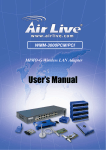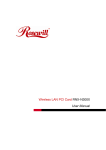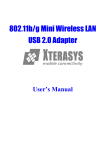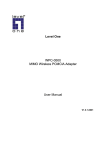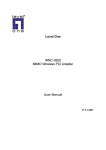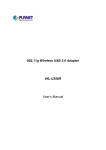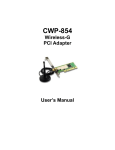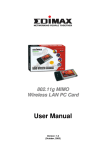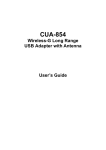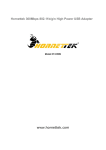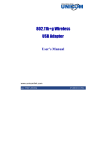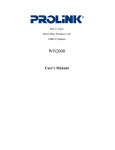Download Abocom WUG2700 User's Manual
Transcript
802.11b/g Mini Wireless LAN USB 2.0 Adapter User’s Manual REGULATORY STATEMENTS FCC Certification The United States Federal Communication Commission (FCC) and the Canadian Department of Communications have established certain rules governing the use of electronic equipment. Part15, Class B This device complies with Part 15 of FCC rules. Operation is subject to the following two conditions: 1) This device may not cause harmful interface, and 2) This device must accept any interface received, including interface that may cause undesired operation. This equipment has been tested and found to comply with the limits for a Class B digital device, pursuant to Part 15 of the FCC Rules. These limits are designed to provide reasonable protection against harmful interference in a residential installation. This equipment generates, uses and can radiate radio frequency energy, and if not installed and used in accordance with the instructions, may cause harmful interference to radio communications. However, there is no guarantee that interference will not occur in a particular installation. If this equipment does cause harmful interference to radio or television reception, which can be determined by turning off and on, the user is encouraged to try to correct the interference by one or more of the following measures: ω Reorient or relocate the receiving antenna. ω Increase the distance between the equipment and receiver. ω Connect the equipment into an outlet on a circuit different from that to which the receiver is connected. CAUTION: 1) To comply with FCC RF exposure compliance requirements, a separation distance of at least 20 cm must be maintained between the antenna of this device and all persons. 2) This transmitter must not be co-located or operating in conjunction with any other antenna or transmitter. Table of Contents INTRODUCTION ...................................................................................................1 TU UT FEATURES ..............................................................................................................1 TU UT SOFTWARE INSTALLATION .............................................................................2 TU UT INSTALL THE DRIVER & UTILITY ............................................................................2 TU UT HARDWARE INSTALLATION............................................................................7 TU UT Verification ................................................................................................8 TU UT NETWORK CONNECTION .................................................................................9 TU UT IN WINDOWS 98SE/ME..........................................................................................9 TU UT IN WINDOWS 2000/XP .........................................................................................12 TU UT IP ADDRESS .........................................................................................................14 TU UT Configuration Utility .............................................................................................15 TU UT STATION MODE ....................................................................................................16 TU UT Profile ......................................................................................................16 TU UT Link Status ...............................................................................................22 TU UT Site Survey...............................................................................................23 TU UT Statistics...................................................................................................24 TU UT Advanced .................................................................................................26 TU UT QoS ..........................................................................................................27 TU UT About .......................................................................................................30 TU UT UTILITY MENU LIST .........................................................................................31 TU UT SOFT AP MODE ....................................................................................................32 TU UT Config ......................................................................................................32 TU UT Access Control .........................................................................................34 TU UT MAC Table ..............................................................................................35 TU UT Event Log ................................................................................................36 TU UT Statistics...................................................................................................37 TU UT About .......................................................................................................38 TU UT UNINSTALLATION .............................................................................................39 TU UT INTRODUCTION The 802.11b/g Mini Wireless LAN USB Adapter is designed for a USB type A port of a laptop or desktop computer for creating a wireless workstation. It is USB 2.0 compliant, which connects to any available USB port on a notebook or desktop computer. T T The 802.11b/g Mini Wireless LAN USB Adapter complies with IEEE 802.11g standard that offers a data rate up to 54Mbps in a wireless LAN environment. It is backward compliant with IEEE 802.11b specification. The high-speed wireless T network card can plug into your notebook or desktop PC and accesses to the LAN or peer-to-peer networking easily without wires or cables. Whether you’re at your desk or in the boardroom, it allows you to share printers, files, and other network resources. T Features Complies with IEEE 802.11g standard for 2.4GHz Wireless LAN USB 2.0 compliant USB Plug & Play Interoperable with existing network infrastructure Secure information transmission Freedom to roam while staying connected Compatible with specialty wireless products and services Up to 54 Mbps data rate Antenna is built in the card with LED indication Low power consumption Easy to install and configure -1- SOFTWARE INSTALLATION Install the Driver & Utility Caution! Do not insert the wireless LAN adapter into your computer until the procedures in “Driver& Utility Installation” have been performed. 1. Exit all Windows programs. Insert the included CD-ROM into your computer. The CD-ROM will run automatically. 2. When the Main Menu screen appears, click “ Driver & Utility Installation” to continue. 3. When the License Agreement screen appears, please read the contents and then click Yes to continue. -2- 4. Select the check box to choose a configuration Tool from the listed two choices. Wireless Configuration Tool: Choose to use our configuration utility. Microsoft Zero Configuration Tool: Choose to use Windows XP’s built-in Zero Configuration Utility (ZCU). Click Next to continue. -3- 5. There are two modes for you to choose in this screen, either choose WiFi mode or performance mode (TxBurst mode). This mode selection screen is set for the default mode shown in the utility screen, you can still change its mode later in the utility screen. Click Next to continue. -4- 6. When you are prompted to insert the wireless USB adapter, please do so to continue the installation. 7. When the following screen appears, you may select to restart your computer immediately or to restart it later, and then click Finish to complete the installation. -5- -6- HARDWARE INSTALLATION Note: Insert the Wireless USB adapter when you are asked to do so during your software installation. Windows 98SE/2000/ME / XP 1. Locate your USB host and insert the USB Adapter. The system will automatically detect the new hardware. -7- Verification To verify if the device exists in your computer and is enabled, go to Start > Control Panel > System (> Hardware) > Device Manager. Expand the Network Adapters category. If the 802.11b/g Mini Wireless LAN USB 2.0 Adapter is listed here, it means that your device is properly installed and enabled. -8- NETWORK CONNECTION Once the device driver is well installed, a network setting described in the following should be also established. In Windows 98SE/ME 1. 2. Go to Start Settings Control Panel Network. Make sure that all the required components are installed. If any components are missing, click on the Add button to add them in. -9- 3. For making your computer visible on the network, enable the File and Print Sharing. 4. Click the Identification tab. Make up a name that is unique from the other computers' names on the network. Type the name of your workgroup, which should be the same used by all of the other PCs on the network. - 10 - 5. Click the Access Control tab. Make sure that “Share-level access control” is selected. If connecting to a Netware server, share level can be set to “User-level access control.” 6. When finished, restart your computer to activate the new device. - 11 - In Windows 2000/XP 1. (In Windows 2000) Go to Start Connections Settings Control Panel Network and Dial-up Local Area Connection Properties. (In Windows XP) Go to Start Control Panel Network and Internet Connections Network Connection Wireless Network Connection Properties. - 12 - 2. Make sure that all the required components are installed. 3. If any components are missing, click on the Install… button to select the Client/Service/Protocol required. After selecting the component you need, click Add… to add it in. 4. For making your computer visible on the network, make sure you have installed File and Printer Sharing for Microsoft Networks. - 13 - IP Address Note: When assigning IP Addresses to the computers on the network, remember to have the IP address for each computer set on the same subnet mask. If your Broadband Router use DHCP technology, however, it won’t be necessary for you to assign Static IP Address for your computer. 1. To configure a dynamic IP address (i.e. if your broadband Router has the DHCP technology), check the Obtain an IP Address Automatically option. 2. To configure a fixed IP address (if you broadband Router is not DHCP supported, or when you need to assign a static IP address), check the Use the following IP address option. Then, enter an IP address into the empty field, for example, enter 192.168.1.1 in the IP address field, and 255.255.255.0 for the Subnet Mask. - 14 - Configuration Utility After the Wireless adapter has been successfully installed, users can use the included Configuration Utility to set their preference. Go to StartJ (All) ProgramJIntelligent Wireless J Intelligent Wireless Utility You can also open the Configuration Utility by double clicking the icon or right clicking to select Launch Config Utilities. - 15 - Station Mode Profile The Profile Manager enables you to create, edit and delete the profiles that the station uses to connect to WLAN networks, to activate and de-activate profiles, and to raise and lower a profiles’s priority. Profile Tab Profile Name You may enter a distinctive name of profile in this column. The default is PROF# (# 1, #2, #3....) SSID The SSID is the unique name shared among all points in your wireless network. Channel Shows the selected channel that is currently in use. (There are 14 channels available, depending on the country.) Authentication Shows the authentication mode of the device. Encryption Shows the encryption mode of the device. Network Type Shows the network type of the device. Add Click to add a profile. - 16 - Configuration tab: Profile Name: Enter a profile name here, the default is set to be PROF1. SSID: The SSID is the unique name shared among all points in your wireless network. The name must be identical for all devices and points attempting to connect to the same network. It shows the current SSID setting of the Wireless USB Adapter. PSM: • CAM-When this mode is selected, the power supply will be normally provided even when there is no throughput. • PSM-When this mode is selected, this device will stay in power saving mode even when there is high volume of throughput. Network Type: Tx Power: Select the Tx power percentage from the pull-down list including Auto, 100%, 75%, 50%, 25%, 10% and Lowest. Preamble: A preamble is a signal used in wireless - 17 - environment to synchronize the transmitting timing including Synchronization and Start frame delimiter. Select from the pull-down menu to change the Preamble type into Long or Short RTS Threshold: RTS/CTS Threshold is a mechanism implemented to prevent the “Hidden Node” problem. If the “Hidden Node” problem is an issue, users have to specify the packet size. The RTS/CTS mechanism will be activated if the data size exceeds the value you set.. The default value is 2347. U U This value should remain at its default setting of 2347. Should you encounter inconsistent data flow, only minor modifications of this value are recommended. Fragment Threshold: The mechanism of Fragmentation Threshold is used to improve the efficiency when high traffic flows along in the wireless network. If your 802. Wireless LAN Adapter often transmit large files in wireless network, you can enter new Fragment Threshold value to split the packet. The value can be set from 256 to 2346. The default value is 2346. Authentication and Security tab: - 18 - Authentication Type: There are three type of authentication modes including Open, Shared, LEAP, WPA-PSK/WPA2-PSK and WPA/WPA2 system. Open: If your access point/wireless router is using "Open " authentication, then the wireless adapter will need to be set to the same authentication type. Shared: Shared Key is when both the sender and the recipient share a secret key. Encryption Type: For open and shared authentication mode, the selection of encryption type are None and WEP. For WPA, WPA2, WPA-PSK and WPA2-PSK authentication mode, the encryption type supports both TKIP and AES. WPA Pre-shared Key: This is the shared secret between AP and STA. For WPA-PSK and WPA2-PSK authentication mode, this field must be filled with character longer than 8 and less than 32 length. WEP Key: Only valid when using WEP encryption algorithm. The key must match with the AP’s key. There are several formats to enter the keys. • Hexadecimal (40bits): 10 Hex characters. • Hexadecimal (128bits): 32Hex characters. - 19 - • ASCII (40bits): 5 ASCII characters. • ASCII (128bits): 13 ASCII characters. 802.1x Setting: When user use radius server to authenticate client certificate for WPA authentication mode. Certification tab: Authentication type: • PEAP: Protect Extensible Authentication Protocol. PEAP transport securely authentication data by using tunneling between PEAP clients and an authentication server. PEAP can authenticate wireless LAN clients using only server-side certificates, thus simplifying the implementation and administration of a secure wireless LAN. • TLS/Smart Card: Transport Layer Security. Provides for certificate-based and mutual authentication of the client and the network. It relies on client-side and server-side certificates to perform authentication and can be used to dynamically generate user-based and session-based WEP keys to secure subsequent communications between the WLAN client and the access point. • TTLS: Tunneled Transport Layer Security. This security method provides for certificate-based, mutual authentication of the client and network through an encrypted channel. Unlike EAP-TLS, EAP-TTLS requires only server-side certificates. - 20 - • LEAP: Light Extensible Authentication Protocol. It is an EAP authentication type used primarily in Cisco Aironet WLANs. It encrypts data transmissions using dynamically generated WEP keys, and supports mutual authentication. • MD5-Challenge: Message Digest Challenge. Challenge is an EAP authentication type that provides base-level EAP support. It provides for only one-way authentication - there is no mutual authentication of wireless client and the network. Session Resumption: user can choose from the pull-down list including Disable, Reauthentication, Roaming, SameSsid, and Always. Identity and Password: Identity and password for server. Use Client Certicate: Client Certicate for server authentication. Tunnel Authentication: • Protocol: Tunnel protocol, List information including EAP-MSCHAP v2, EAP-TLS/Smart card, and Generic Token Card. • Tunnel Identity: Identity for tunnel. • Tunnel Password: Password for tunnel. CA Server: Certificate Authority Server. Each certificate is signed or issued by it. CA Server tab: Certificate issuer: Choose the issuer of certificates. Allow intimidate certificates: It must be in the server - 21 - certificate chain between the server certificate and the server specified in the certificate issuer must be field. Server name: Enter an authentication sever root. Add Click to add a profile. Delete Click to delete an existing profile. Edit Click to edit a profile. Activate Click to make a connection between devices. OK Click to exit this page. Link Status The link status page displays the detail information of current connection. Link Status Tab Status Shows the current connection status. If there is no connection existing, it will show Disconnected. Extra Info Shows the link status. - 22 - Channel Shows the current channel in use. Link Speed Shows the current transmitting rate and receiving rate. Throughput Shows the transmitting and receiving throughput in the unit of K bits/sec. Link Quality Shows the connection quality based on signal strength and TX/RX packet error rate. Signal Strength Shows the Receiving signal strength, you can choose to display as percentage or dBm format. Noise Level Shows the noise signal strength. OK Click to exit this page. Site Survey The Site Survey page displays the information of surrounding APs from last scan result. List information including SSID, BSSID, Signal, Channel, Encryption algorithm, and Network type. - 23 - Site Survey SSID Shows the name of BSS of IBSS network. BSSID Shows the MAC address of the AP or randomly generated of IBSS. Signal Shows the receiving signal strength of specified network. Channel Shows the currently used channel. Encryption Shows the encryption type currently in use. Valid value includes WEP, TKIP, AES, and Not Use. Authentication Authentication mode used within the network, including Unknown, WPA-PSK, WPA2-PSK, WPA and WPA2. Network Type Network type in use, Infrastructure for BSS, Ad-Hoc for IBSS network. Rescan Click to refresh the site survey list. Connect Select an item on the list and then click to make a connection. Add to Profile Select an item on the list and then click to add it into the Profile list. OK Click to exit this page. Statistics Statistics page displays the detail counter information based on 802.11 MIB counters. This page translates that MIB counters into a format easier for user to understand. - 24 - Transmit Statistics Frames Transmitted Successfully Frames successfully sent. Frames Transmitted Successfully Without Retry Frames successfully sent without any retry. Frames Transmitted Successfully After Retry Frames successfully sent with one or more reties. Frames Fail To Receive ACK After All Retries Frames failed transmit after hitting retry limit. RTS Frames Successfully Receive CTS Successfully receive CTS after sending RTS frame RTS Frames Fail To Receive CTS Failed to receive CTS after sending RTS. Receive Statistics Frames Received Successfully Frames Received Successfully Frames Received With CRC Error Frames received with CRC error. Frames Dropped Due To Frames dropped due to resource issue - 25 - Out-of-Resource Duplicate Frames Received Duplicate received frames. Reset Counter Reset counters to zero. Advanced This Advanced page provides advanced settings. Advanced Tab Wireless mode Select wireless mode. 802.11b only and 802.11 b/g mixed mode are supported Ad hoc wireless mode Select ad hoc wireless mode. 802.11b only and 802.11 b/g mixed mode are supported. B/G Protection Choose Auto, On or Off from the pull-down menu. Auto: STA will dynamically change as AP announcement On: Always send frame with protection. Off: Always send frame without protection. TX Rate Select the Tx rate from the pull-sown menu. The default is auto. - 26 - Tx Burst Check to enable the burst mode. Enable TCP Window Size Check to increase the transmission quality. Fast Roaming at Check to set the roaming interval. Select Your Country Region Code Select your country region code from the pull-down menu. CCX2.0: support Cisco Compatible Extensions function: Check to enable the CCX2.0 function. • LEAP turn on CCKM • Enable Radio Measurement: Check to enable the Radio measurement function. • Non-Serving Measurement: can channel measurement every 0~2000 milliseconds. Radio Off/On Click to turn off the radio function. Apply Click to apply the above settings. OK Click to exit this page. QoS - 27 - WMM Enable: Place a check in the check box, and then click Apply to enable Power Save or Direct Link Setup. • WMM Power Save Enable: Place a check in the check box, and then click Setting to select which ACs you want to enable. Click Apply to save the configuration. • Direct Link Setup Enable: Place a check in the check box, and then click Apply. Afterwards, change to Site Survey page, add an AP that supports DLS features to a Profile. The setting of DLS: Fill in the blanks of Direct Link with MAC Address of STA, and the STA must conform to two conditions: 1. Connecting with the same AP that supports DLS feature. 2. DSL enabled. - 28 - The Timeout value- it will become disconnected after the timeout value you set. The value is integer, and must be between 0~65535. If the value is set to 0, then it will never be disconnected. The default value is 60seconds. After you have done all the settings, click Apply to save them, and the result will be shown in the DLS status field (the MAC address and timeout value will be shown in the Status field). - 29 - About This page displays the wireless card and driver version information - 30 - UTILITY MENU LIST To access the utility menu list, please right click the utility icon on the task bar. Launch Config Utilities: Select to open the utility screen. Use Zero Configuration as Configuration utility: Select to use the Window XP built-in utility (Zero configuration utility). Switch to AP Mode: Select to make your wireless USB adapter act as a wireless AP. Exit: Select to close the utility program. - 31 - Soft AP mode Config Wireless mode SSID Country Region Code B/G Protection Select wireless mode.802.11 b/g mixed, 802.11b only and 802.11g only mode are supported. System default is 802.11 b/g mixed. AP name of user type. User also can select [Use Mac Address] to display it. System default is SoftAP-31. Eight countries to choose. Country channel list: Classification Range 0: FCC (Canada) CH1 ~CH11 1: ETSI CH1 ~CH13 2: SPAIN CH10 ~CH11 3: FRANCE CH10 ~CH13 4: MKK CH14 ~CH14 5: MKKI (TELEC) CH1~CH14 6: ISRAEL CH3 ~CH9 7: ISRAEL CH5 ~CH13 ERP protection mode of 802.11G definition. User can chose Auto, on, or off, the system default is Auto. - 32 - Preamble Beacon (ms) TX Power TX Rate Channel Auth. Vs. Security TX Burst No forwarding among wireless clients Hide SSID Use Short Slot Auto Channel Selected at next boot Default Apply Auto: STA will dynamically change as AP announcement. On: Always send frame with protection. Off: Always send frame without protection. Preamble frames. Long preamble (128 bits sync field) and short preamble (56 bits sync field) are supported. The system default is long preamble. The time between two beacons. The system default is 100 ms. Manually force the AP transmits power. The system default is 100%. Manually force the Transmit using selected rate. The system default is auto. Manually force the AP using the channel. The system default is CHl-1. Authentication mode and encryption algorithm used within the AP. The system default is no authentication and encryption. Place a check in the check box to enable the TX Burst function. No beacon among wireless client, clients can share information each other. The system default is no forwarding. Do not display AP name. System default no hide. Slot time. Short slot time is 9 us, long slot time is 20 us. System default is long slot time. System will make a random channel at the next boot (PCI device only). Use the system default value. Click to apply the above settings. - 33 - Access Control Access Policy Mac Address Access List Delete Remove All Apply User chooses whether AP start the function. System default is disabling. Manually force the Mac address using the function. Click Add and the MAC address will be listed in the Access List pool. Display all Mac Address that you have set. Delete the Mac address that you have set. Remove all Mac address in the Access List. Apply the above changes. - 34 - MAC Table MAC Address AID Power Saving Mode The station Mac address of current connection. Raise value by current connection. The station of current connect whether it have to support. - 35 - Event Log Event Time (yy/mm/dd-hh:mm:ss) Message Records the event time. Records all the event messages. - 36 - Statistics Transmit Statistics Frames Transmitted Successfully Frames successfully sent. Frames Transmitted Successfully Without Retry Frames successfully sent without any retry. Frames Transmitted Successfully After Retry Frames successfully sent with one or more reties. Frames Fail To Receive ACK After All Retries Frames failed transmit after hitting retry limit. RTS Frames Successfully Receive CTS Successfully receive CTS after sending RTS frame RTS Frames Fail To Receive CTS Failed to receive CTS after sending RTS. Receive Statistics Frames Received Successfully Frames Received Successfully Frames Received With CRC Error Frames received with CRC error. - 37 - Frames Dropped Due To Out-of-Resource Frames dropped due to resource issue Duplicate Frames Received Duplicate received frames. Reset Counter Reset counters to zero. About This page displays the wireless card and driver version information. - 38 - UNINSTALLATION In case you need to uninstall the Utility and driver, please refer to below steps. (As you uninstall the utility, the driver will be uninstalled as well.) 1. Go to Start Programs 802.11bg LAN USB. Intelligent Wireless 2. 3. Select Remove All to start uninstalling. Select Yes, I want to restart my computer now to complete the uninstallation. - 39 - Uninstall –











































